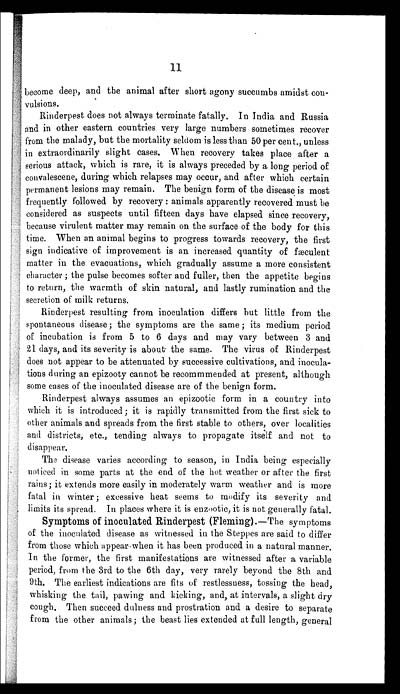Medicine - Veterinary > Civil Veterinary Departments > Civil Veterinary Department ledger series I-VI > Volume I - Rinderpest - cattle plague
(33) Page 11
Download files
Individual page:
Thumbnail gallery: Grid view | List view

11
become deep, and the animal after short agony succumbs amidst con-
vulsions.
Rinderpest does not always terminate fatally. In India and Russia
and in other eastern countries very large numbers sometimes recover
from the malady, but the mortality seldom is less than 50 per cent., unless
in extraordinarily slight cases. When recovery takes place after a
serious attack, which is rare, it is always preceded by a long period of
convalescene, during which relapses may occur, and after which certain
permanent lesions may remain. The benign form of the disease is most
frequently followed by recovery : animals apparently recovered must be
considered as suspects until fifteen days have elapsed since recovery,
because virulent matter may remain on the surface of the body for this
time. When an animal begins to progress towards recovery, the first
sign indicative of improvement is an increased quantity of fæculent
matter in the evacuations, which gradually assume a more consistent
character ; the pulse becomes softer and fuller, then the appetite begins
to return, the warmth of skin natural, and lastly rumination and the
secretion of milk returns.
Rinderpest resulting from inoculation differs hut little from the
spontaneous disease; the symptoms are the same; its medium period
of incubation is from 5 to 6 days and may vary between 3 and
21 days, and its severity is about the same. The virus of Rinderpest
does not appear to be attenuated by successive cultivations, and inocula-
tions during an epizooty cannot be recommmended at present, although
some cases of the inoculated disease are of the benign form.
Rinderpest always assumes an epizootic form in a country into
which it is introduced; it is rapidly transmitted from the first sick to
other animals and spreads from the first stable to others, over localities
and districts, etc., tending always to propagate itself and not to
disappear.
The disease varies according to season, in India being especially
noticed in some parts at the end of the hot weather or after the first
rains; it extends more easily in moderately warm weather and is more
fatal in winter; excessive heat seems to modify its severity and
limits its spread. In places where it is enzootic, it is not generally fatal.
Symptoms of inoculated Rinderpest (Fleming).—The symptoms
of the inoculated disease as witnessed in the Steppes are said to differ
from those which appear-when it has been produced in a natural manner.
In the former, the first manifestations are witnessed after a variable
period, from the 3rd to the 6th day, very rarely beyond the 8th and
9th. The earliest indications are fits of restlessness, tossing the head,
whisking the tail, pawing and kicking, and, at intervals, a slight dry
cough. Then succeed dulness and prostration and a desire to separate
from the other animals; the beast lies extended at full length, general
Set display mode to: Large image | Zoom image | Transcription
Images and transcriptions on this page, including medium image downloads, may be used under the Creative Commons Attribution 4.0 International Licence unless otherwise stated. ![]()
| India Papers > Medicine - Veterinary > Civil Veterinary Departments > Civil Veterinary Department ledger series I-VI > Rinderpest - cattle plague > (33) Page 11 |
|---|
| Permanent URL | https://digital.nls.uk/75515863 |
|---|




